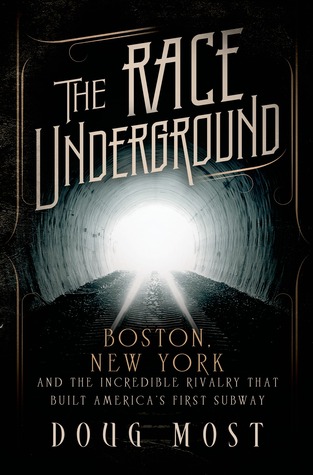Author: Doug Most
Publisher: St. Martin's Press
Publication Date: February 4, 2014
Source: ARC received from the publisher for an honest review
Summary from Goodreads:
In the late nineteenth century, as cities like Boston and New York grew more congested, the streets became clogged with plodding, horse-drawn carts. When the great blizzard of 1888 crippled the entire northeast, a solution had to be found. Two brothers from one of the nation's great families—Henry Melville Whitney of Boston and William Collins Whitney of New York—pursued the dream of his city digging America's first subway, and the great race was on. The competition between Boston and New York played out in an era not unlike our own, one of economic upheaval, life-changing innovations, class warfare, bitter political tensions, and the question of America’s place in the world. The Race Underground is peopled with the famous, like Boss Tweed, Grover Cleveland and Thomas Edison, and the not-so-famous, from brilliant engineers to the countless "sandhogs" who shoveled, hoisted and blasted their way into the earth’s crust, sometimes losing their lives in the construction of the tunnels. Doug Most chronicles the science of the subway, looks at the centuries of fears people overcame about traveling underground and tells a story as exciting as any ever ripped from the pages of U.S. history. The Race Underground is a great American saga of two rival American cities, their rich, powerful and sometimes corrupt interests, and an invention that changed the lives of millions.
My Review:
I grew up in an area of Connecticut that is basically the midpoint between New York and Boston on I-95. I've ridden the T several times, and I've logged many (maaaaaany) hours on NYC subways and commuter rails. It's hard to imagine either of these cities without their subway systems--with such congested streets, underground travel is quick, affordable, and convenient. So I was intrigued by a book that offered to bring to life the 100+ year history of subways in these two metropolises.
Doug Most opens the book with an introduction that hints to the important roles that Henry and William Whitney (two brothers from Massachusetts) played in the openings of the Boston and New York subways, respectively. He then takes us through early attempts at subway designs, the engineering inventions that gradually made them more plausible, and the many struggles that builders and politicians went through in order to eventually make them a reality. Finally, we see the subways being constructed and opening in each city (which one first? You have to read to find out!).
In terms of comprehensiveness, this book can't be beat. Most definitely did his homework on this subject, and has provided intricate details that left me impressed by how specific his sources were. The history of underground travel really is fascinating, and I loved getting this glimpse at how engineering innovations developed quickly within 5, 10, 50 year periods. Makes you wonder how far we'll come by 2050. And Most doesn't stop at giving particulars about the subways. Every major contributor to these projects is introduced with lots of information about their pasts, families, etc., so you really get a human element there as well.
While I did appreciate the attention to detail, there were several structural elements in this book that frustrated me. First was the formatting, in terms of how the history was unfolded. As I mentioned before, it is implied at the beginning of the book that the Boston and New York subway systems had their beginnings with the Whitney brothers. However, as I read on, I felt more and more that the Whitneys were not the central characters in this story. Yes, they both played notable roles in their respective cities with the subway projects, but in the end, neither of them would be credited as anything close to the "father" of either system. This left me confused as to why Most chose to structure the book around them, and gave it a bit of a disjointed feel, as many other (arguably more important) players were continually introduced throughout the book.
Possibly because of this odd choice in structure, the book as a whole doesn't flow very well. There were whole paragraphs in certain chapters that seemed poorly placed, with details that weren't especially relevant to the rest of the section.
Final verdict: if you have a true interest in history, innovation, and engineering, the story that Most provides here is top-notch. But there is a significant downside in how he chose to structure the book, which does tend to take away from the finer details at times.
Have you ever ridden a subway, reader friends? Where was it, and what did you think? Is it a preferred route of travel for you, or are you an above-grounder at heart?














This sounds like a great topic -- too bad about the structural problems with the book. I grew up in the Seattle area (no subways, though they finally got light rail), but lived near New York for years. I was very proud when I learned to navigate the NYC subway system, which is not the most comprehensible in the world.
ReplyDeleteIt takes some getting used to, but it makes sense to me now. Boston's T though...nope nope nope. haha.
DeleteIt's too bad that the book wasn't organized in the best way possible, because it sounds well done otherwise. I've had similar experiences with several nonfiction books lately, where I've felt as though they were focusing on something other than the main topic of the book and it made for much less enjoyable reading.
ReplyDeleteYes, I don't know why they do that! In this case, I felt like the author was trying to create a bit of familial drama or competition where there wasn't any.
DeleteAw man, what a bummer. I'd be fascinated by a good quick moving narrative non-fiction about subways. Heck, I might read it anyway, I'm suddenly fascinated by the idea.
ReplyDeleteChicago is mentioned here and there, so the midwesterners aren't entirely ignored! :)
Delete